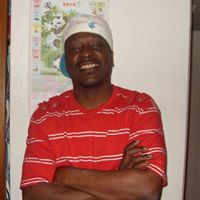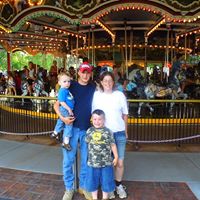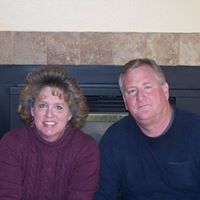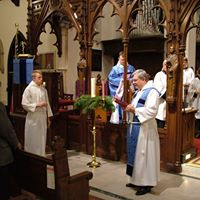David Lovelace
from Mesa, AZ
David Lovelace Phones & Addresses
- Mesa, AZ
Work
-
Company:Smsc analog technology center inc
-
Address:3930 E Ray Rd Ste 110, Phoenix, AZ 85044
-
Phones:4807590200
-
Position:Partner
-
Industries:Engineering Services
Resumes

David Lovelace
view source
David Lovelace
view source
David Lovelace
view source
David Lovelace
view source
David Lovelace
view source
David Lovelace
view source
David Lovelace
view source
Employee
view sourceWork:
Integration Technology Group
Employee
Employee
Medicine Doctors

David M. Lovelace
view sourceSpecialties:
Emergency Medicine, Family Medicine
Work:
Citizen Potawatomi Nation Health
2307 Gordon Cooper Dr, Shawnee, OK 74801
4058784693 (phone), 4058784835 (fax)
2307 Gordon Cooper Dr, Shawnee, OK 74801
4058784693 (phone), 4058784835 (fax)
Education:
Medical School
Oklahoma State University Center for Health Sciences College of Osteopathic Medicine
Graduated: 1987
Oklahoma State University Center for Health Sciences College of Osteopathic Medicine
Graduated: 1987
Procedures:
Destruction of Benign/Premalignant Skin Lesions
Electrocardiogram (EKG or ECG)
Skin Tags Removal
Vaccine Administration
Electrocardiogram (EKG or ECG)
Skin Tags Removal
Vaccine Administration
Conditions:
Acne
Acute Bronchitis
Acute Conjunctivitis
Acute Pharyngitis
Acute Sinusitis
Acute Bronchitis
Acute Conjunctivitis
Acute Pharyngitis
Acute Sinusitis
Languages:
English
Description:
Dr. Lovelace graduated from the Oklahoma State University Center for Health Sciences College of Osteopathic Medicine in 1987. He works in Shawnee, OK and specializes in Emergency Medicine and Family Medicine.
License Records
David Lewis Lovelace
License #:
5279 - Expired
Category:
Nursing Home Administrator
Issued Date:
Oct 16, 2007
Name / Title
Company / Classification
Phones & Addresses
Partner
Smsc Analog Technology Center Inc
Engineering Services
Engineering Services
3930 E Ray Rd Ste 110, Phoenix, AZ 85044
Partner
Smsc Analog Technology Center, Inc
Integrated Circuit & Chip Design · Engineering Services
Integrated Circuit & Chip Design · Engineering Services
3930 E Ray Rd, Phoenix, AZ 85044
4807590200
4807590200
BUCKHORN TAVERN, INC
Us Patents
-
Radio Frequency Electronic Switch
view source -
US Patent:6487395, Nov 26, 2002
-
Filed:Mar 16, 1998
-
Appl. No.:09/039502
-
Inventors:Jeffrey C. Durec - Chandler AZ
David Kevin Lovelace - Chandler AZ
Mark D. Randol - Mesa AZ -
Assignee:Motorola, Inc. - Schaumburg IL
-
International Classification:H04Q 720
-
US Classification:455 78, 455 83
-
Abstract:A radio frequency (RF) switch ( ) for use in a wireless communication system operated in a time delay division mode of operation. The switch includes a pair of PIN diodes ( and ) serially coupled between the transmitter and receiver paths of the communication system which share a common node ( ) to which a bias voltage is provided. The bias voltage is switched between first and second voltage levels to alternately cause one and the other of the pin diodes to be forward biased while the other is reversed bias. In this manner the transmitter and receiver paths will be alternately shorted to alternating current ground while the other path is shorted to a common node to an antenna.
-
Crystal Oscillator With Control Feedback To Maintain Oscillation
view source -
US Patent:6819196, Nov 16, 2004
-
Filed:Feb 13, 2003
-
Appl. No.:10/366177
-
Inventors:David K. Lovelace - Chandler AZ
Klaas Wortel - Phoenix AZ -
Assignee:Standard Microsystems Corporation - Hauppauge NY
-
International Classification:H03B 532
-
US Classification:331183, 331158, 331 16
-
Abstract:An oscillator circuit. In one embodiment, the oscillator includes a gain circuit, an envelope detector, and an amplitude comparison circuit. The trans-conductance circuit is configured to amplify a periodic signal produced by a crystal. Amplitude peaks of the periodic signal may be detected in the envelope detector, which may determine an average amplitude value based on the detected peaks. The average amplitude value may be compared to a DC voltage value in an amplitude comparison circuit. The DC voltage value may include both a DC average of the periodic signal as well as a predetermined DC offset value. The gain circuit may adjust the level of amplification of the periodic signal based on a feedback signal in order to ensure that the oscillator produces a periodic output signal at a desired level so as to insure oscillation and the minimum use of current to achieve oscillations.
-
Selective Implementation Of Power Management Schemes Based On Detected Computer Operating Environment
view source -
US Patent:7055047, May 30, 2006
-
Filed:Apr 9, 2003
-
Appl. No.:10/410089
-
Inventors:Klaas Wortel - Phoenix AZ, US
David K. Lovelace - Chandler AZ, US
Luis J. Briones - Chandler AZ, US -
Assignee:Standard Microsystems Corporation - Hauppauge NY
-
International Classification:G06F 1/32
-
US Classification:713320, 713300
-
Abstract:Detecting a radio frequency (RF) environment around a computer and using a power management scheme for an RF user input device being used by the computer system. If the computer system is in a single user environment, a power management scheme may be used to conserve power on the RF user input device. If the computer system is in a multi-user environment, a power management scheme may be used to minimize interference between neighboring computer systems by minimizing the signal strength of the RF signal from the RF user input device and the RF signal from the computer system.
-
Current-Mode Direct Conversion Receiver
view source -
US Patent:7415260, Aug 19, 2008
-
Filed:Mar 8, 2004
-
Appl. No.:10/795740
-
Inventors:Troy L. Stockstad - Chandler AZ, US
Klaas Wortel - Phoenix AZ, US
Luis J. Briones - Chandler AZ, US
David Lovelace - Austin TX, US -
Assignee:Standard Microsystems Corporation - Hauppauge NY
-
International Classification:H04B 1/00
-
US Classification:455312, 455324
-
Abstract:A current-mode direct conversion RF receiver is presented. In one set of embodiments the RF receiver comprises a simple transconductor input stage to create a current-mode modulated signal from a voltage-mode modulated signal. A downconversion mixer may be coupled to the transconductor input stage via a low impedance current cascode stage, and may operate to create a set of current-mode quadrature baseband signals from the current-mode modulated signal. The downconversion mixer may be implemented with a transistor-switching network, which may be driven by a phase locked loop (PLL) with quadrature outputs. The set of current-mode quadrature baseband signals may be converted back to the voltage domain by a transimpedance filter, which may perform channel selection for the receiver. The transimpedance filter may additionally include a low frequency zero to remove DC offsets. The receiver may be implemented using CMOS design technologies and operated with minimal self-mixing effects, minimal DC offset in the baseband signal, and utilizing low voltages.
-
Circuit And Method For Correcting Phase Error In A Multiplier Circuit
view source -
US Patent:56592639, Aug 19, 1997
-
Filed:Mar 25, 1996
-
Appl. No.:8/622536
-
Inventors:Stephen W. Dow - Chandler AZ
David K. Lovelace - Chandler AZ
Jeffrey C. Durec - Chandler AZ -
Assignee:Motorola, Inc. - Schaumburg IL
-
International Classification:G06F 744
-
US Classification:327356
-
Abstract:A circuit and method for reducing a phase error at the output terminal (48) of a multiplier circuit (41) is provided. The phase error arises when first and second input signals having asymmetric signal paths are multiplied in the multiplier circuit (41). A second multiplier circuit (42) multiplies the in-phase and quadrature signals and produces an output signal at an output terminal (49) which contains the phase error but with the opposite polarity as the phase error produced by the first multiplier circuit (41). The signals at the output terminals (48) and (49) are summed in a summing circuit (43) to produce a third output signal in which the phase error is canceled.
-
Phase Detector Circuit And Method Of Phase Detecting
view source -
US Patent:61378526, Oct 24, 2000
-
Filed:Dec 23, 1997
-
Appl. No.:8/996903
-
Inventors:Michael McGinn - Tempe AZ
David Kevin Lovelace - Chandler AZ -
Assignee:Motorola, Inc - Schaumburg IL
-
International Classification:H03D 324
-
US Classification:375375
-
Abstract:An image reject receiver (10) uses a mixer circuit (12) and a mixer circuit (16) to frequency translate an incoming reference signal (RF. sub. IN) and generate a first output signal (V. sub. OUT1) and a second output signal (V. sub. OUT2), respectively. Two phase detectors (26 and 36) measure a phase difference between the first and second output signals (V. sub. OUT1, and V. sub. OUT2) and a difference circuit (30) provides a difference value in accordance with the phase difference. The difference value cancels any phase shift due to time delays associated with the phase detectors (26 and 36). The difference value is fed back to a phase shift circuit (20) for adjusting the phase of the second output signal (V. sub. OUT2) and locking the first output signal (V. sub. OUT1) in-phase with the second output signal (V. sub. OUT2).
-
Base Current Compensation Circuit
view source -
US Patent:56170564, Apr 1, 1997
-
Filed:Jul 5, 1995
-
Appl. No.:8/498038
-
Inventors:William E. Main - Mesa AZ
David K. Lovelace - Chandler AZ -
Assignee:Motorola, Inc. - Schaumburg IL
-
International Classification:G05F 110
-
US Classification:327538
-
Abstract:A base current compensation circuit (10) generates a current that tracks a gain of a transistor (11). The compensation circuit (10) includes a current mirror formed by a mirror transistor (12) and an output transistor (14). The mirror transistor (12) is connected to the transistor (11) whose gain is tracked. A current source (16) and a feedback transistor (13) causes the mirror transistor (12) to draw a base current from the transistor (11) so that a collector current of the transistor (11) matches a reference current. The output transistor (14) amplifies the base current of the transistor (11) to generate the tracking current in the collector electrode of the output transistor (14).
-
High Frequency Differential To Single-Ended Converter
view source -
US Patent:6177832, Jan 23, 2001
-
Filed:Jul 6, 1998
-
Appl. No.:9/110289
-
Inventors:Jeffrey C. Durec - Chandler AZ
David Kevin Lovelace - Chandler AZ -
Assignee:Motorola, Inc. - Schaumburg IL
-
International Classification:H03F 304
-
US Classification:327563
-
Abstract:A differential to single-ended converter which combines a pair of applied differential signals of a given frequency applied into a single-ended signal supplied to an output thereof, including capacitive means (14,16 or 36) coupled across a pair of terminals to which the differential signals are applied and transmission line circuitry (18, or 38, 40) coupled across the capacitive means for shifting the phase of one of the differential signals applied to one of the pair of terminals such that it is in phase with the other one of the differential signals applied at the other of the pair of terminals wherein said signals are combined into a single-ended signal and applied to an output of the converter.
Youtube
Myspace
Flickr
Plaxo

David Lovelace
view sourceBoston, MASenior Business Development Executive, Marketing S... Past: Director of Resort Marketing at ResortCom International

David Lovelace
view sourceGranite Mountain Termite Pest Control

David Lovelace
view sourceTex oma Builders Supply

David Lovelace
view sourceITG
Classmates

David Lovelace
view sourceSchools:
Chapman High School Chapman KS 1988-1992
Community:
Dustin White, Kim Hassler

David Lovelace
view sourceSchools:
Mohawk High School Mohawk NY 1974-1978
Community:
Zinny Politis, Deborah Quackenbush, Rich R, Terry Bowers

David Lovelace
view sourceSchools:
Chapman High School Chapman KS 1988-1992
Community:
Dustin White, Kim Hassler

David Lovelace
view sourceSchools:
Oakwood Academy Huntsville AL 1992-1996
Community:
Linda Hodge, Tammie Clark, Bonnie Barber

David Lovelace
view sourceSchools:
Welch High School Welch OK 1969-1973
Community:
Ronnie Simmons, Linda Jones, Paula Whisamore, Jerry Gray, Lonny Freeman, Ed Wood, Cindy Jones, Lisa Ewers, Ter Mac, Marquetta Ketta, Clifford Same

David Lovelace (Southwic...
view sourceSchools:
Southwick High School Southwick MA 1979-1983
Community:
Sherri Carpenter, Jeff Sponberg, James Bennett, Kathleen Johnson

Oakwood Academy, Huntsvil...
view sourceGraduates:
David Lovelace (1992-1996),
Vello Martin (1958-1962),
Sabrina Cotton (1982-1986),
Kelly Hoormann (1986-1991),
H Frederick (1976-1980),
James McKinney (1967-1971)
Vello Martin (1958-1962),
Sabrina Cotton (1982-1986),
Kelly Hoormann (1986-1991),
H Frederick (1976-1980),
James McKinney (1967-1971)

Chapman High School, Chap...
view sourceGraduates:
David Lovelace (1988-1992),
Dawn Lyon (1954-1958),
Susan Zook (1977-1981),
Michael Martinitz (1976-1980),
Audrey Schwab (1953-1957)
Dawn Lyon (1954-1958),
Susan Zook (1977-1981),
Michael Martinitz (1976-1980),
Audrey Schwab (1953-1957)
Googleplus

David Lovelace
Tagline:
Got Triassic?

David Lovelace

David Lovelace

David Lovelace

David Lovelace

David Lovelace

David Lovelace
Work:
CenturyLink - Sales Engineer III

David Lovelace
view source
David Wade Lovelace
view source
David Lovelace
view source
David Lovelace
view source
David Lovelace
view source
David Lovelace
view source
David Lovelace
view source
David Lovelace
view sourceGet Report for David Lovelace from Mesa, AZ
















